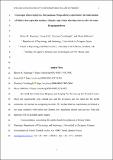Files in this item
Great apes (Pan troglodytes, Pan paniscus, Pongo abelii) exploit better the information of failure than capuchin monkeys (Sapajus spp.) when selecting tools to solve the same foraging problem
Item metadata
| dc.contributor.author | Manrique, Héctor M | |
| dc.contributor.author | Call, Josep | |
| dc.contributor.author | Visalberghi, Elisabetta | |
| dc.contributor.author | Sabbatini, Gloria | |
| dc.date.accessioned | 2021-11-18T13:30:02Z | |
| dc.date.available | 2021-11-18T13:30:02Z | |
| dc.date.issued | 2021-05 | |
| dc.identifier | 272951426 | |
| dc.identifier | 48f82dba-f211-4bc0-9f37-a2b7630b29a5 | |
| dc.identifier | 33492157 | |
| dc.identifier | 000668221900014 | |
| dc.identifier | 85111788973 | |
| dc.identifier.citation | Manrique , H M , Call , J , Visalberghi , E & Sabbatini , G 2021 , ' Great apes ( Pan troglodytes, Pan paniscus, Pongo abelii ) exploit better the information of failure than capuchin monkeys ( Sapajus spp.) when selecting tools to solve the same foraging problem ' , Journal of Comparative Psychology , vol. 135 , no. 2 , pp. 273-279 . https://doi.org/10.1037/com0000242 | en |
| dc.identifier.issn | 0735-7036 | |
| dc.identifier.other | Jisc: ef7d738d2e8f4f21b599f11c57af0a55 | |
| dc.identifier.other | pii: 2021-10583-001 | |
| dc.identifier.other | ORCID: /0000-0002-8597-8336/work/89178452 | |
| dc.identifier.uri | https://hdl.handle.net/10023/24356 | |
| dc.description.abstract | In a previous study, chimpanzees, bonobos, orangutans, and capuchin monkeys faced a task that required the use of a rigid stick-like tool to displace an out-of-reach food reward, which was located outside the cage either hanging on a string (e.g., apes) or on a table (e.g., capuchins). Three unfamiliar stick-like tools were placed on a wooden platform for the subjects to choose. Testing consisted of two consecutive trials, each with the same set of tools. Previous to the test subjects learned about the rigidity of the tool either by handling the tools (manipulation), or by observing an experimenter bending and unbending them in sequence (observation); or did not receive any information since the three tools were presented lying on the platform (visual static). In the current study, we investigated whether failing to select the right type of tool in the first trial affected subjects' choices in the second trial. Results showed that when information about the tool rigidity was obtained before selection, great apes and capuchin monkeys changed options in their second choices. However, in the visual static condition, where no information about the rigidity of the tools had been provided before their selection, only great apes discarded wrong tool exemplars in their second trials benefitting from their own mistakes. In contrast, capuchin monkeys did not. We argue that lower attentional focus and lack of stimuli distinctiveness might account for capuchins monkeys' failure to benefit from their own experience. | |
| dc.format.extent | 7 | |
| dc.format.extent | 515127 | |
| dc.language.iso | eng | |
| dc.relation.ispartof | Journal of Comparative Psychology | en |
| dc.subject | Attention | en |
| dc.subject | Tool choice | en |
| dc.subject | Tool use | en |
| dc.subject | Preservation | en |
| dc.subject | Primates | en |
| dc.subject | BF Psychology | en |
| dc.subject | 3rd-DAS | en |
| dc.subject | AC | en |
| dc.subject.lcc | BF | en |
| dc.title | Great apes (Pan troglodytes, Pan paniscus, Pongo abelii) exploit better the information of failure than capuchin monkeys (Sapajus spp.) when selecting tools to solve the same foraging problem | en |
| dc.type | Journal article | en |
| dc.contributor.institution | University of St Andrews. Organic Semiconductor Centre | en |
| dc.contributor.institution | University of St Andrews. School of Psychology and Neuroscience | en |
| dc.contributor.institution | University of St Andrews. Centre for Social Learning & Cognitive Evolution | en |
| dc.identifier.doi | 10.1037/com0000242 | |
| dc.description.status | Peer reviewed | en |
This item appears in the following Collection(s)
Items in the St Andrews Research Repository are protected by copyright, with all rights reserved, unless otherwise indicated.

